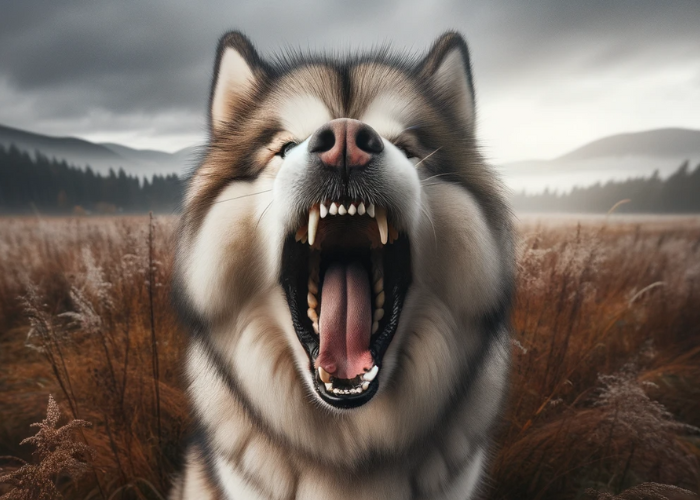The Alaskan Malamute, a breed known for its strength and endurance, often raises questions about its temperament. Many wonder, “Are Alaskan Malamute Dangerous?”
Alaskan Malamutes are not inherently dangerous. They are generally friendly and sociable, especially towards humans. However, their behavior can be influenced by factors like upbringing, training, and environment. Proper training and socialization are key to managing their behavior.
Join us as we dive into the world of Alaskan Malamutes and uncover the truth about their temperament and behavior. You won’t want to miss what makes them special!
Key Takeaways
- Alaskan Malamutes are not inherently dangerous but require proper training and socialization.
- They are generally friendly and sociable, especially towards humans.
- Training Alaskan Malamutes can be challenging due to their independent nature.
- Malamutes may show aggression in specific contexts, such as same-sex dog aggression or possessiveness over food.
- Compared to other breeds, Malamutes have moderate levels of aggression and high energy levels.
- Proper training and socialization are essential to minimize any aggressive tendencies.
- They have a strong prey drive, requiring careful supervision around small animals.
- Health factors like hypothyroidism or joint pain can influence their behavior.
- Malamutes are best suited for active owners with ample space and experience in dog training.
- The decision to own an Alaskan Malamute should be well-informed, considering both the challenges and rewards of the breed.
Alaskan Malamute Behavior Insights
Alaskan Malamutes are known for their friendly and affectionate nature. However, like any breed, their behavior can be influenced by various factors, including their upbringing, training, and environment.
Specific Training Needs of Alaskan Malamutes

Alaskan Malamutes are highly-intelligent yet independent-minded dogs. This can make training them challenging for novice owners.
However, with the proper techniques and commitment, Malamutes can become well-behaved companions:
- Use positive reinforcement training methods, not harsh corrections
- Require patience and consistency from owners
- Start training basic obedience early (sit, stay, come)
- Socialize extensively with other dogs from a young age
- Introduce household pets early due to high prey drive
- Set firm boundaries for puppies to prevent problem behaviors
- Don’t allow cute puppy behaviors to progress into problems
- Owners must establish themselves as pack leader
- With proper training, Malamutes can be well-mannered companions
Alaskan Malamutes require dedicated training and socialization from an early age to shape good behaviors.
Owners must be firm, consistent pack leaders to gain respect from these strong-willed dogs.
With time and positive methods, Malamutes can become obedient and friendly companions. Their intelligence allows them to excel at training if handled properly.
Contextual Factors Influencing Aggression

While generally friendly, Alaskan Malamutes may show aggression in certain contexts:
- Same-sex dog aggression, especially between males
- Possessiveness over food, toys, or sleeping areas
- Protectiveness of family members or property
- Fear, if not properly socialized
- Pain or sickness
- Dominance seeking, if leadership is unclear
- Malamutes may resort to aggression to assert dominance without proper socialization and training.
- Neglect or abuse can also provoke aggressive behaviors.
Owners should establish clear leadership, train impulse control, and socialize Malamutes extensively to minimize aggression.
Alaskan Malamutes Compared to Other Breeds

To fully understand the temperament of Alaskan Malamutes, it’s helpful to compare their behavior and potential for aggression with other breeds.
| Aspect | Alaskan Malamutes | Other Breeds |
|---|---|---|
| Energy Level | Higher | Varies by breed |
| Prey Drive | Stronger | Varies by breed |
| Same-Sex Aggression | More likely | Less likely (e.g., retrievers, spaniels, Siberian Husky) |
| Biddability | More independent thinkers | More biddable (e.g. herding breeds like collies) |
| Aggressiveness (Guarding) | Less aggressive | More aggressive (e.g. Akitas, Chow Chows, Doberman Pinschers) |
| Overall Aggressiveness | Comparable to an average dog with proper training and care | Varies by breed |
This table provides a brief overview, but it’s important to note that individual temperament can vary widely within any breed.
Proper training, socialization, and care are essential for any dog, regardless of breed.
Detailed Statistics on Alaskan Malamute Aggression

- According to the American Temperament Test Society, Alaskan Malamutes pass temperament tests at an 85.4% rate, similar to Golden Retrievers.
- A study in Germany found dog bites requiring hospitalization were very rare for Malamutes, but the exact rate was unknown.
- In a survey of aggression in ancient dog breeds, Malamutes showed aggression to other dogs at a 46.55% rate, lower than Akitas (58.89%) and Basenjis (54.69%).
- Aggression in humans was reported in Malamutes, but the exact percentage was unknown.
- A UK study found Malamutes were responsible for at least one fatal dog bite incident between 1981-2022.
- It is noted that Alaskan Malamutes have been involved in fatal attacks in the US.
Overall statistics indicate Malamutes show moderate levels of aggression, similar to or lower than other large working breeds.
Proper training and socialization are key to minimizing any aggressive tendencies.
Personal Experiences and Case Studies

Personal experiences and case studies provide a wealth of information about the behavior and characteristics of Alaskan Malamutes. Here are some insights gathered from various sources:
- A Reddit user shared their experience raising a Malamute in an apartment with a large park nearby. They mentioned that the dog was kind, didn’t bark much, and required lots of physical activities. They also highlighted the importance of socializing the dog from a young age.
- A case study of an Alaskan Malamute named Suka revealed that the dog had a sensitive stomach, a recurring issue since it was eight weeks old.
- An award-winning children’s author, Anna Grob, shared her life with Alaskan Malamutes. She described them as affectionate companions, big clowns, powerful, and beautiful. She also emphasized that Malamutes are working dogs that need lots of exercise and something to keep them busy.
- O’Mal Alaskan Malamutes shared several firsthand stories about Alaskan Malamutes, highlighting their unique behaviors, such as their tendency to dig, their psychic-like abilities, and their love for food.
- A case study on a 10-year-old Alaskan Malamute suffering from chronic osteoarthritis and myofascial restriction highlighted the health issues that can affect the breed.
- A case study on an Alaskan Malamute suffering from a neuromuscular disease called Alaskan Malamute Polyneuropathy (AM-PN) highlighted the genetic health risks associated with the breed.
- An Alaskan Arctic Expedition with Alaskan Malamutes provided a firsthand experience of the breed’s strength, endurance, and working ability in their native land.
These personal experiences and case studies highlight the diverse characteristics of Alaskan Malamutes, including their physical needs, behavioral traits, and potential health issues.
They underscore the importance of understanding the breed’s unique requirements and potential challenges before adopting or purchasing an Alaskan Malamute.
Alaskan Malamutes and Their Prey Drive

Alaskan Malamutes were bred to hunt, so they have a strong prey drive. This means they instinctively want to chase small animals like cats, squirrels, or rabbits. Malamute owners should take precautions:
- Supervise interactions with small pets and teach gentle behavior
- Keep Malamutes leashed or separated from household cats/small pets if prey drive is high
- Introduce any new pets slowly and carefully
- Provide outlets like playtime, chew toys, or lure coursing to satisfy prey drive
- Train a solid “leave it” command and reinforce it with treats
Malamutes can learn to coexist peacefully with small pets with time and effort. But owners must be vigilant and understand this breed’s inherent prey instincts.
Health Factors Influencing Alaskan Malamute Behavior

- Hypothyroidism can cause increased aggression. Annual thyroid testing is recommended.
- Arthritis or joint pain can lead to irritability or aggression if the dog is touched near sore areas. Keeping the dog at a healthy weight is important.
- Seizures may result in periods of confusion or anxiety afterward. Medication can help control seizures.
- Cancer or other painful conditions could provoke aggressive reactions. Veterinary care is essential.
- Age-related cognitive decline could lead to confusion, anxiety, or aggression. Regular vet checks help monitor behavior changes.
Any sudden behavior changes in adult Malamutes should prompt a full veterinary workup to identify potential health issues.
Addressing any medical problems can help improve or resolve behavior problems.
Alaskan Malamutes’ Suitability for Diverse Owners and Households

Good Matches:
- Active singles, couples, or families able to provide ample exercise
- Households with large fenced yards
- Experienced dog owners familiar with training working breeds
- Owners wanting a friendly but independent-minded dog
- Households without small pets or willing to monitor interactions
Poor Matches:
- Sedentary owners unable to provide enough exercise
- People looking for an obedient, biddable breed
- First-time dog owners unfamiliar with training
- Households with small children or elderly members who could get knocked over
- Apartments or small homes without a yard
- Households with small pets like cats, rabbits, etc.
The high-energy exercise needs and independent nature of Alaskan Malamutes make them better suited to active owners able to provide proper training and outlets for their energy.
They require ample space and are not ideal for homes with small pets or children.
Careful consideration should be given to ensure this breed will be a good match before bringing one home.
But with the right owners and environment, Malamutes can make excellent companion dogs.
Conclusion

Alaskan Malamutes are a unique breed with their own set of challenges. Due to their working breed nature, they require consistent training, plenty of exercise, and ample space.
However, they can make loyal, affectionate pets with the proper care and commitment.
This article has aimed to provide a balanced view of the breed, addressing common concerns and misconceptions.
The decision to own a Malamute should be well-informed, considering both the challenges and rewards that come with it.
REFERENCES:
- American Temperament Test Society, Inc. (2023, September 22). ATTS Breed Statistics. https://atts.org/breed-statistics/statistics-page1/
- NCBI. (2021, May 17). The Influence of Breed, Sex, Origin and Housing Conditions on Undesirable Behaviors in Ancient Dog Breeds. https://www.ncbi.nlm.nih.gov/pmc/articles/PMC8156398/
- Wikipedia. (2023, September 29). List of fatal dog attacks in the United Kingdom. https://en.wikipedia.org/wiki/List_of_fatal_dog_attacks_in_the_United_Kingdom
- Hooman’s Friend. (2023, March 5). Alaskan Malamute Temperament: Independence and a loving heart. https://www.hoomansfriend.com/post/alaskan-malamute-temperament-resilient-independence-paired-with-a-people-loving-heart
- Forbes Advisor. (2023, October 2). Dog Attack Statistics By Breed In 2023. https://www.forbes.com/advisor/legal/dog-attack-statistics-breed/
- ResearchGate. (2023, March 9). The Influence of Breed, Sex, Origin and Housing Conditions on Undesirable Behaviors in Ancient Dog Breeds. https://www.researchgate.net/publication/351677946_The_Influence_of_Breed_Sex_Origin_and_Housing_Conditions_on_Undesirable_Behaviors_in_Ancient_Dog_Breeds
- Globalnews.ca. (2014, March 17). Alaskan malamutes have history of deadly attacks. https://globalnews.ca/news/1213114/alaskan-malamutes-have-history-of-fatal-attacks/
- AAA State of Play. (2023, October 12). [PDF] RANKED BY TEMPERAMENT. https://www.aaastateofplay.com/media/wysiwyg/docs/114-dog-breeds-ranked-by-temperament_PDF.pdf

